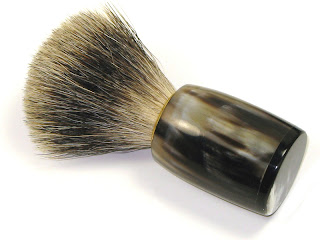03/09/2012, Saat: 16:36

http://asuitablewardrobe.dynend.com/2012...chive.html
A recent car commercial featured various very serious-looking men earnestly rhapsodizing about their fetishized possessions, A v-neck-sweatered man describes with delicate gestures his pen’s warthog tusk barrel and solid titanium trim. Another fellow poses by his tube amplifier and states smugly, “It reproduces frequencies only dogs can hear.” And so on. While (prior to looking it up in order to write this) I had forgotten what the commercial actually was for, it absolutely nailed the mannerisms of a particular male demographic that collects and obsesses over the minutiae of the overdesigned.
Thanks to Internet message boards and forums, the obsessed now know they are not alone. Both a sounding board and an echo chamber, these communities encourage members in their mania, spread a creed of received ideas and insulate them from skepticism – but not from rationalization. Insulated though we are, those of us obsessively focused on acquiring the rarest, best performing or most prestigious widget are still only slightly less obsessed with coming up with ways to justify our possessions. (I understand some members of the audiophile forums got their thousand-dollar power cables in a bunch over tube amp man.) I come to my thesis: We become ridiculous when we try to justify luxury. I henceforth adopt the following working definition of luxury: that done well which does not need to be done at all (Commenters, feel free to quibble below, but parsing that is a subject for another article). And with this piece I open my cabinet of curiosities, little luxuries that may be interesting or entertaining to the casual internet punter. These are things that are different, amusing, that at one time or another made me happy. Stop me if I start trying to intellectualize them.
Whether it’s shaving, skiing or cooking, the best part of any new hobby is the new toys it forces you to buy. Years ago, fed up with the latest nasty shaving gels, I tried old-fashioned shaving creams and was pleased with the results. The traditional creams and shaving soaps lasted a long time, were less harsh on my skin, and seemed to make for a closer, more comfortable shave than the modern stuff in most drugstores. Of course, then I needed a shaving brush for the ritual of applying the cream. (Real enthusiasts would add a proper shaving mug to foam up shaving soap in hot water and a straight (a.k.a. cut-throat) razor, but I try to be neither pedantic nor suicidal.)
I started unassumingly enough with the sort of brush with floppy nylon bristles that comes bundled in shaving gift packs. Those occupy the bottom of the shaving brush hierarchy, along with prickly and painfully stiff boar-bristled brushes. Infinitely preferable are brushes made with badger hair (humanely removed so that he can go boating with Mole and the Water Rat afterwards). Supposedly, badger hair possesses the ideal properties (for shaving brushes and, one assumes, badgers) of being able to absorb a great deal of water while being both springy and soft at the tip in order to lather up well without irritation.
As with any obsession, there are multiple grades of badger quality, florid names, and disputes over standards of nomenclature, with various companies offering “Best Badger,” “Super Badger” (great image) and “Silvertip.” Generally speaking, Silvertip is the top of most makers’ lines, and may be conflated with Super Badger by certain makers. I worked my way up to the luxury of a Silvertip with what the catalogs call a “faux ivory” handle, which is a euphemism for off-white plastic. (That’s fine, I don’t begrudge Tantor his tusks.) The Silvertip was a hell of a lot better than the cheap synthetic stuff. However, as with all obsessions, there is no limit on how far one can go up the hyperbolic curve of diminishing returns.
After Pure Badger, Best Badger, Super Badger and Silvertip, there are a few outliers offered by a couple of companies. What I had my eye on and eventually acquired was something called High Mountain Badger, a bristle step above Silvertip and so appealingly rare (I saw a badger in the Alps last spring, but I didn’t get a chance to ask if it was high). As an added draw, the brush itself was made with polished oxhorn handles instead of the usual plastic, adding that sensual element of visual pleasure which attracts the over-thinking enthusiast. To my knowledge, horn is generally a byproduct of the food industry and comes from the common cow, so my indulgence wasn’t plundering an endangered resource.
How does it perform? The hairs are pretty dense, the brush feels very good and foams up well, and in general seems better than my late Silvertip. So in other words, the difference could all be in my head. The price? At this place on the hyperbola, nothing is worth it from a sheer cost-benefit standpoint. Quality is remembered long after price is intentionally blotted out of one’s memory. In the end, our continued attempts to justify the unjustifiable luxury aren’t just aimed at others, but at ourselves and the impending recognition that even our latest, most elaborate acquisition can’t keep the doubts away for long. Perhaps the badger brush arms race will ramp up once someone finds a way to harness the power of Internet phenomenon the honey badger. At a certain point, though, to keep your sanity you need to make like him and just not give a shit.




